
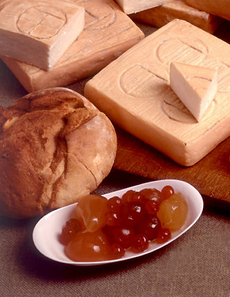
Taleggio, from Italy, is a “borderline stinky” cheese. Some people like it so much, they don’t think it’s stinky at all. Photo courtesy Wikimedia.
|
STEPHANIE ZONIS, Contributing Editor, focuses on good foods and the people who produce them.
|
|
October 2007
Last Updated September 2012
|
 |
Stinky Cheeses
Only The Brave Deserve The Funky: A Guide To Stinky Cheeses
- Click here to read other months’ Whey To Go columns
Overview
You know what they’re like. You’ve seen (or smelled) them before. They’re runny, moldy and look positively decrepit, if such a word can be used to describe a cheese. There’s not much in the way of middle ground here; either you love these so-called stinky cheeses, with their strong tastes and aromas, or you stay as far away from them as you possibly can. This article is dedicated to those among us with a penchant for these odiferous fromages. Incidentally, if you regard the term “stinky” as too juvenile to use, be aware that it is in such widespread use that the websites of some highly-regarded cheese retailers allow you to conduct searches for “stinky” cheese!
Since you need to know what to ask for (or stay away from) in the cheese case, what are some of the better-known varieties? Here are five you should know about.
- Limberger. The classic example in the U.S. used to be Limburger, although its availability seems greatly diminished today. Originally created by Belgian Trappist monks and
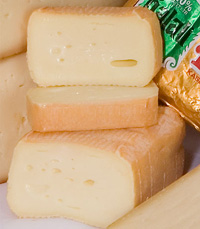 copied by the Germans, it was further copied by a New Yorker named Emil Frey in the 1880s, and called Liederkranz. Limburger is a washed-rind, pasteurized cow’s cheese (the rind is washed in brine), with a soft, Brie-like interior and a somewhat salty, strong flavor. Encyclopedia Britannica Online says of this cheese, “The celebrated odour develops as the cheese ripens…The flavour of Limburger is pronounced, but not as strong as the odour, which can be detected at a considerable distance when the cheese is exposed.” The pungent aroma comes from the bacteria that live in the rind; trim the rind and tame the cheese. copied by the Germans, it was further copied by a New Yorker named Emil Frey in the 1880s, and called Liederkranz. Limburger is a washed-rind, pasteurized cow’s cheese (the rind is washed in brine), with a soft, Brie-like interior and a somewhat salty, strong flavor. Encyclopedia Britannica Online says of this cheese, “The celebrated odour develops as the cheese ripens…The flavour of Limburger is pronounced, but not as strong as the odour, which can be detected at a considerable distance when the cheese is exposed.” The pungent aroma comes from the bacteria that live in the rind; trim the rind and tame the cheese.
SERVE LIMBERGER WITH: German lager beer or Riesling; rye bread or dark bread with with cold cuts, mustard and pickles; crackers, fruits, crudités.
- Stinking Bishop. If you’re a fan of the series “Wallace & Gromit,” no doubt you’re familiar with Stinking Bishop, a very strong cheese that dates back to the Cistercian monks, an austere order founded in 1028 and focused on manual labor and field work. A
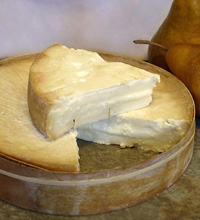 version was developed in modern times by Charles Martell, a U.K. cheesemaker and most unusual man. Once, on the final day of a food exhibition in Italy, I saw Mr. Martell step from behind his booth into an aisle and read aloud a poem—in English—praising the Gloucester cattle with which he farms. Many of the attendees, almost all of whom were Italian, couldn’t possibly have understood what he was saying, but he received a nice round of applause when he concluded. Stinking Bishop is another member of the pasteurized cow’s milk washed-rind family, but the rind here is bathed in perry, an alcoholic pear cider, and develops a stinky, pungent, orange-colored, sticky rind.The cheese itself is not named after a bishop of the Cistercians, but the Stinking Bishop pear varietal. version was developed in modern times by Charles Martell, a U.K. cheesemaker and most unusual man. Once, on the final day of a food exhibition in Italy, I saw Mr. Martell step from behind his booth into an aisle and read aloud a poem—in English—praising the Gloucester cattle with which he farms. Many of the attendees, almost all of whom were Italian, couldn’t possibly have understood what he was saying, but he received a nice round of applause when he concluded. Stinking Bishop is another member of the pasteurized cow’s milk washed-rind family, but the rind here is bathed in perry, an alcoholic pear cider, and develops a stinky, pungent, orange-colored, sticky rind.The cheese itself is not named after a bishop of the Cistercians, but the Stinking Bishop pear varietal.
SERVE STINKING BISHOP WITH: A bread and dessert wine: Ice wine, Muscat de Beaumes de Venise or a lighter Sauternes (we enjoy Stinking Bishop with a raisin semolina bread).
- Epoisses. The full name of this lovely stinker is Epoisses de Bourgogne, made in a tiny town in the Burgundy region of France), another washed-rind cheese. Do you see a trend here? You should; many stinky cheeses are of the washed-rind type. This
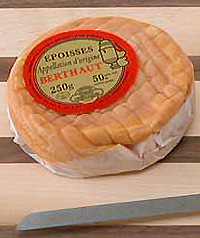 rind is bathed in a local brandy called marc de Bourgogne, then buried in a cellar for four weeks. Like Limburger and Stinking Bishop, Epoisses has very big flavors; it also has a particularly strong scent—it is so odoriferous that it is banned on public transportation in France, a country that considers it to be one of its greatest cheeses (and it is!). The red-brown rind is edible; the creamy interior smells like it came straight from the barnyard. Unfortunately, the real Epoisses is a raw milk product, aged for less than 60 days and not allowed to be imported into the U.S. until it is more than 60 days old. The pasteurized-milk impostor seen in the U.S. just doesn’t taste good, in my opinion. igourmet.com imports Epoisses the day it turns 60, so get one and enjoy it within the week. rind is bathed in a local brandy called marc de Bourgogne, then buried in a cellar for four weeks. Like Limburger and Stinking Bishop, Epoisses has very big flavors; it also has a particularly strong scent—it is so odoriferous that it is banned on public transportation in France, a country that considers it to be one of its greatest cheeses (and it is!). The red-brown rind is edible; the creamy interior smells like it came straight from the barnyard. Unfortunately, the real Epoisses is a raw milk product, aged for less than 60 days and not allowed to be imported into the U.S. until it is more than 60 days old. The pasteurized-milk impostor seen in the U.S. just doesn’t taste good, in my opinion. igourmet.com imports Epoisses the day it turns 60, so get one and enjoy it within the week.
SERVE EPOISSES WITH: Rustic bread or baguette, ham, dark fruits and an aged Burgundy.
- Pont L’Eveque. This ancient Norman cheese dates back to the 13th century.
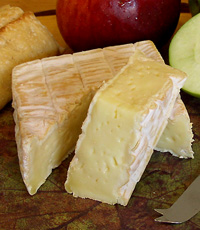 Made on the coast of Normandy with rich salt milk, the cheese is made in small squares, nested in individual wood boxes and aged for 45 days. This particular cheese is made from “near-pasteurized cow’s milk; the original version is made with raw milk and can’t be brought in (by the time it is 60 days old, it is past its prime). While the paste is creamy with full-bodied flavor and a bouquet reminiscent of the French countryside, it is quite aromatic—a “little stinker.” Made on the coast of Normandy with rich salt milk, the cheese is made in small squares, nested in individual wood boxes and aged for 45 days. This particular cheese is made from “near-pasteurized cow’s milk; the original version is made with raw milk and can’t be brought in (by the time it is 60 days old, it is past its prime). While the paste is creamy with full-bodied flavor and a bouquet reminiscent of the French countryside, it is quite aromatic—a “little stinker.”
SERVE PONT L’EVEQUE WITH: Crusty French bread and full-bodied rich, red wine or hot or cold cider—it was created to go with the great ciders of Normandy, where they serve it for breakfast as well as after dinner. Serve it with pears and apples.
- Taleggio. Some retailers and cheesemongers classify Taleggio as stinky, while others do not, proving that stinky can be very much in the mind of the beholder. Often called the “Italian Brie,”
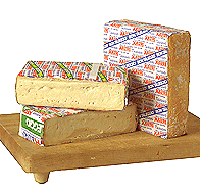 Taleggio, from the Lombardy region, boasts a flavor that cheese maestro Steven Jenkins describes as “beefy,” and I’d have to agree. It’s also got a nutty, buttery quality to it. Taleggio is a member of the Italian stracchino family of cheeses—meaning that meaning it was made with the milk of stracchio or “tired” cattle that were milked while on their way to (or back from) their seasonal pastures. It has a rosy-golden, inedible rind. The paste is gooey, soft and creamy, yet incredibly pungent and flavorful. It is often made in a square. Taleggio is a good melting cheese—Italians melt it on top of polenta or portabello mushrooms. It’s a good snacking cheese with ham, salami, fruit and bread. It’s a good cheese board cheese, too. (See the unwrapped photo of taleggio at the top of the page.) Taleggio, from the Lombardy region, boasts a flavor that cheese maestro Steven Jenkins describes as “beefy,” and I’d have to agree. It’s also got a nutty, buttery quality to it. Taleggio is a member of the Italian stracchino family of cheeses—meaning that meaning it was made with the milk of stracchio or “tired” cattle that were milked while on their way to (or back from) their seasonal pastures. It has a rosy-golden, inedible rind. The paste is gooey, soft and creamy, yet incredibly pungent and flavorful. It is often made in a square. Taleggio is a good melting cheese—Italians melt it on top of polenta or portabello mushrooms. It’s a good snacking cheese with ham, salami, fruit and bread. It’s a good cheese board cheese, too. (See the unwrapped photo of taleggio at the top of the page.)
SERVE TALEGGIO WITH: Crusty bread, Valpolicella or a Beaujolais. It can be served with white wines too—Frascati, Lugana, Orvieto, Sauvignon Blanc, Soave, Verdicchio and others.
Taleggio photo courtesy of Di Bruno Brothers. All other photos courtesy igourmet.
While these few stinky cheeses have good public recognition, there are many other varieties available. Ask your cheesemonger what’s available and taste away.
All About Stinkies
There are significant misconceptions about these cheeses, unfortunately. Many people believe that all goat cheeses are stinky, but that’s untrue. Some goat cheeses are decidedly pungent in both aroma and flavor, yes, and goat’s milk does have a perceptible tang, which will reflect in the taste of any cheese fabricated from it. But good hygiene also has a great deal to do with the character of any animal’s milk, and goats that live in very clean environments produce milk that’s positively delicate in nature. A less-aged goat cheese made from such milk will be of a gentler character. In fact, The Surreal Gourmet website declares that, while cheeses made from sheep’s and goat’s milk can be more pungent, the vast majority of stinky cheeses are made from cow’s milk.
Another common belief among those who don’t know better is that stinky cheeses have gone bad. To be sure, cheese is a perishable food, and it can indeed become unfit for consumption, at which time it will give off a strong odor. It’s also true that soft, ripened cheeses (Brie, Camembert, etc.) can become overripe. If that happens, it’s likely they’ll carry a definite, if not strong, smell of ammonia. But a real, well-matured stinky cheese is neither spoiled nor overripe; it’s just got great strength of character!
If you’re wondering how it’s possible that such strong-smelling, runny fermented curd 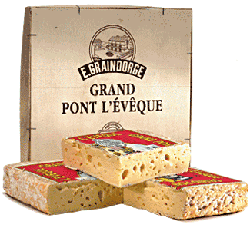 (with mold on it, yes) could appeal to anyone, remember that taste is a very subjective matter. Some people actually prefer foods with stronger aromas and flavors. The website CheeseReviews.org has a very intelligent response to this inquiry: Many preferences for stinky cheese are cultural in nature. In the U.S., we’re raised to expect a germ-free, odor-free environment. If something is clean, or if it smells “clean,” that’s a plus. Anything with a strong odor, especially food, is going to raise a psychological question mark (or outright alarm) with us, even if that odor is derived from a natural source. (with mold on it, yes) could appeal to anyone, remember that taste is a very subjective matter. Some people actually prefer foods with stronger aromas and flavors. The website CheeseReviews.org has a very intelligent response to this inquiry: Many preferences for stinky cheese are cultural in nature. In the U.S., we’re raised to expect a germ-free, odor-free environment. If something is clean, or if it smells “clean,” that’s a plus. Anything with a strong odor, especially food, is going to raise a psychological question mark (or outright alarm) with us, even if that odor is derived from a natural source.
Pont l’Eveque from Di Bruno Brothers.
The same holds true with strong flavors; and if you haven’t noticed, most Americans eat bland foods. An excellent example of this is fermented fish sauce—the number one condiment throughout Asia (and the favorite condiment of the wealthy in the Roman Empire, because it was an expensive condiment, bestowed as gifts the way we give wine). The liquid drained from fermented fish, nam pla of Thailand or the garum of the ancient Romans wouldn’t appeal to most Americans. But people from other cultures are raised with more pungent aromas and tastes, so powerful scents and flavors are desirable. (Read a detailed discussion of garum and the ancient fish sauces of Asia.)
The Source Of Stinkiness
How do stinky cheeses become stinky? In a word, bacteria. All cheeses depend upon bacteria for their very existence. But one bacterium, Brevibacterium linens, is responsible for the majority of stinky cheese aromas and tastes. B. linens is a fussy sort and insists on a warm, moist environment in order to flourish. It lives chiefly on the surface of a cheese. As populations of B. linens increase, the rind of the cheese will usually take on a color that’s a cross between pink and orange, and the bacteria release specific flavor compounds not always found in typical American foods. These can be earthy, mushroomy, or reminiscent of hay, among others.
Stinky cheeses are often referred to as being “an acquired taste.” If that sounds like a euphemism, it isn’t meant to. It’s more of a cultured taste. The mighty aromas and flavors of these cheeses can be overwhelming for the younger set, who tend to have very sensitive palates. One’s tastes change as one ages, however, and strongly-scented, strongly-flavored foods are often more appreciated by those beyond their twenties or thirties. And, some people may live to a ripe (no pun intended) old age without ever liking any cheese stronger than mild Cheddar or Swiss.
Serving Stinky Cheeses
If you’re wondering about uses for stinky cheeses, they have a somewhat more limited range than an all-purpose “workhorse” of the cheese world. But unlike that  “workhorse,” stinky cheeses are not meant to be all things to all consumers. Even the stinkiest example among these products can be used in some recipes (a brief web search for the particular cheese you have in mind should be all you’ll require), but their true glory is often best established in a simple pairing with a wine or beer, some fruit, a toothsome loaf, or some good crackers. If you need to select an alcoholic beverage for your stinky cheese but aren’t sure where to turn, ask a good cheesemonger, or simply surf over to a reputable cheese website. Just remember that their pairings are simply suggestions, not ironclad rules! You might also wish to include a stinky cheese as part of a cheese tasting. If you’re planning a tasting of three or four cheeses, make sure you start with your mildest product and work up in flavor strength and aroma; if you try the reverse, the assertive nature of your stinky cheese will overwhelm the others you sample. “workhorse,” stinky cheeses are not meant to be all things to all consumers. Even the stinkiest example among these products can be used in some recipes (a brief web search for the particular cheese you have in mind should be all you’ll require), but their true glory is often best established in a simple pairing with a wine or beer, some fruit, a toothsome loaf, or some good crackers. If you need to select an alcoholic beverage for your stinky cheese but aren’t sure where to turn, ask a good cheesemonger, or simply surf over to a reputable cheese website. Just remember that their pairings are simply suggestions, not ironclad rules! You might also wish to include a stinky cheese as part of a cheese tasting. If you’re planning a tasting of three or four cheeses, make sure you start with your mildest product and work up in flavor strength and aroma; if you try the reverse, the assertive nature of your stinky cheese will overwhelm the others you sample.
If you are not a fan of bold flavors and scents in your food, it may be the case that you’ll never appreciate stinky cheeses. But if you’ve never tried them through simple fear of the unknown, step up to the (cheese) plate! A knowledgeable retailer will make sure you get a well-matured, great example of any of these cheeses. Ignore their appearance and take a bite. You’ll be rewarded with multiple layers of complex flavors that partner perfectly with a stout-hearted beer, an intrepid wine or just some good seasonal fruit. Truly, good things can come in funky packages.
Cheese of the Month: Gorgonzola Piccante
A time-honored Italian blue, Gorgonzola is not necessarily a stinky cheese; you have to find the right type of it. A young Gorgonzola, usually called a “dolce” (the Italian word for “sweet”), will still have a powerful aroma, but the cheese itself will not be of as strong a flavor. A Gorgonzola dolce will be aged for a few months.
Extend that aging period to a year or longer, however, and you’ll have a blue that is worthy of the “stinky” appellation. This powerhouse is variously called Gorgonzola piccante, Gorgonzola di monte (Mountain Gorgonzola), or Gorgonzola naturale—by whichever name you choose, it is shown in the photo at the right. |
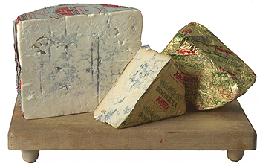
Gorgonzola Piccante from DiBruno.com. |
Several sources agree that the piccante variety has a rind both thicker and dryer than that of a dolce, with a whiter interior and veins of mold that are both bluer and darker than its younger sibling. The piccante tends toward a firmer, somewhat crumbly texture, with a combination flavor of a spicy bite, the tang of a blue, and the buttery smoothness of a full-fat cow’s milk cheese. This is not a subtle dairy product!
You can use Gorgonzola piccante in recipes ranging from salads to stuffed chicken or veal entrées to stuffed figs. It’s used as a salad topping, or simply enjoyed with wine. I’ve seen suggestions for wine ranging from sweet, white, Italian dessert wines to big Italian reds, such as Chianti or Barolo. This should be a good indication both of the versatility of this cheese and the fact that there are few hard and fast rules in matching cheeses with wines! As far as availability of Gorgonzola piccante, if you do not live near a good cheese retailer, try DiBruno.com, ArtisanalCheese.com or MurraysCheese.com.
Sources
Lifestyle Direct, Inc. All rights reserved. Images are the copyright of their respective owners.

|





 copied by the Germans, it was further copied by a New Yorker named Emil Frey in the 1880s, and called Liederkranz.
copied by the Germans, it was further copied by a New Yorker named Emil Frey in the 1880s, and called Liederkranz.  version was developed in modern times by Charles Martell, a U.K. cheesemaker and most unusual man. Once, on the final day of a food exhibition in Italy, I saw Mr. Martell step from behind his booth into an aisle and read aloud a poem—in English—praising the Gloucester cattle with which he farms. Many of the attendees, almost all of whom were Italian, couldn’t possibly have understood what he was saying, but he received a nice round of applause when he concluded. Stinking Bishop is another member of the pasteurized cow’s milk washed-rind family, but the rind here is bathed in perry, an alcoholic pear cider, and develops a stinky, pungent, orange-colored, sticky rind.The cheese itself is not named after a bishop of the Cistercians, but the Stinking Bishop pear varietal.
version was developed in modern times by Charles Martell, a U.K. cheesemaker and most unusual man. Once, on the final day of a food exhibition in Italy, I saw Mr. Martell step from behind his booth into an aisle and read aloud a poem—in English—praising the Gloucester cattle with which he farms. Many of the attendees, almost all of whom were Italian, couldn’t possibly have understood what he was saying, but he received a nice round of applause when he concluded. Stinking Bishop is another member of the pasteurized cow’s milk washed-rind family, but the rind here is bathed in perry, an alcoholic pear cider, and develops a stinky, pungent, orange-colored, sticky rind.The cheese itself is not named after a bishop of the Cistercians, but the Stinking Bishop pear varietal. rind is bathed in a local brandy called marc de Bourgogne, then buried in a cellar for four weeks. Like Limburger and Stinking Bishop, Epoisses has very big flavors; it also has a particularly strong scent—it is so odoriferous that it is banned on public transportation in France, a country that considers it to be one of its greatest cheeses (and it is!). The red-brown rind is edible; the creamy interior smells like it came straight from the barnyard. Unfortunately, the real Epoisses is a raw milk product, aged for less than 60 days and not allowed to be imported into the U.S. until it is more than 60 days old. The pasteurized-milk impostor seen in the U.S. just doesn’t taste good, in my opinion. igourmet.com imports Epoisses the day it turns 60, so get one and enjoy it within the week.
rind is bathed in a local brandy called marc de Bourgogne, then buried in a cellar for four weeks. Like Limburger and Stinking Bishop, Epoisses has very big flavors; it also has a particularly strong scent—it is so odoriferous that it is banned on public transportation in France, a country that considers it to be one of its greatest cheeses (and it is!). The red-brown rind is edible; the creamy interior smells like it came straight from the barnyard. Unfortunately, the real Epoisses is a raw milk product, aged for less than 60 days and not allowed to be imported into the U.S. until it is more than 60 days old. The pasteurized-milk impostor seen in the U.S. just doesn’t taste good, in my opinion. igourmet.com imports Epoisses the day it turns 60, so get one and enjoy it within the week.  Made on the coast of Normandy with rich salt milk, the cheese is made in small squares, nested in individual wood boxes and aged for 45 days. This particular cheese is made from “near-pasteurized cow’s milk; the original version is made with raw milk and can’t be brought in (by the time it is 60 days old, it is past its prime). While the paste is creamy with full-bodied flavor and a bouquet reminiscent of the French countryside, it is quite aromatic—a “little stinker.”
Made on the coast of Normandy with rich salt milk, the cheese is made in small squares, nested in individual wood boxes and aged for 45 days. This particular cheese is made from “near-pasteurized cow’s milk; the original version is made with raw milk and can’t be brought in (by the time it is 60 days old, it is past its prime). While the paste is creamy with full-bodied flavor and a bouquet reminiscent of the French countryside, it is quite aromatic—a “little stinker.” Taleggio, from the Lombardy region, boasts a flavor that cheese maestro Steven Jenkins describes as “beefy,” and I’d have to agree. It’s also got a nutty, buttery quality to it. Taleggio is a member of the Italian stracchino family of cheeses—meaning that meaning it was made with the milk of stracchio or “tired” cattle that were milked while on their way to (or back from) their seasonal pastures. It has a rosy-golden, inedible rind. The paste is gooey, soft and creamy, yet incredibly pungent and flavorful. It is often made in a square. Taleggio is a good melting cheese—Italians melt it on top of polenta or portabello mushrooms. It’s a good snacking cheese with ham, salami, fruit and bread. It’s a good cheese board cheese, too. (See the unwrapped photo of taleggio at the top of the page.)
Taleggio, from the Lombardy region, boasts a flavor that cheese maestro Steven Jenkins describes as “beefy,” and I’d have to agree. It’s also got a nutty, buttery quality to it. Taleggio is a member of the Italian stracchino family of cheeses—meaning that meaning it was made with the milk of stracchio or “tired” cattle that were milked while on their way to (or back from) their seasonal pastures. It has a rosy-golden, inedible rind. The paste is gooey, soft and creamy, yet incredibly pungent and flavorful. It is often made in a square. Taleggio is a good melting cheese—Italians melt it on top of polenta or portabello mushrooms. It’s a good snacking cheese with ham, salami, fruit and bread. It’s a good cheese board cheese, too. (See the unwrapped photo of taleggio at the top of the page.)  (with mold on it, yes) could appeal to anyone, remember that taste is a very subjective matter. Some people actually prefer foods with stronger aromas and flavors. The website CheeseReviews.org has a very intelligent response to this inquiry: Many preferences for stinky cheese are cultural in nature. In the U.S., we’re raised to expect a germ-free, odor-free environment. If something is clean, or if it smells “clean,” that’s a plus. Anything with a strong odor, especially food, is going to raise a psychological question mark (or outright alarm) with us, even if that odor is derived from a natural source.
(with mold on it, yes) could appeal to anyone, remember that taste is a very subjective matter. Some people actually prefer foods with stronger aromas and flavors. The website CheeseReviews.org has a very intelligent response to this inquiry: Many preferences for stinky cheese are cultural in nature. In the U.S., we’re raised to expect a germ-free, odor-free environment. If something is clean, or if it smells “clean,” that’s a plus. Anything with a strong odor, especially food, is going to raise a psychological question mark (or outright alarm) with us, even if that odor is derived from a natural source.  “workhorse,” stinky cheeses are not meant to be all things to all consumers. Even the stinkiest example among these products can be used in some recipes (a brief web search for the particular cheese you have in mind should be all you’ll require), but their true glory is often best established in a simple pairing with a wine or beer, some fruit, a toothsome loaf, or some good crackers. If you need to select an alcoholic beverage for your stinky cheese but aren’t sure where to turn, ask a good cheesemonger, or simply surf over to a reputable cheese website. Just remember that their pairings are simply suggestions, not ironclad rules! You might also wish to include a stinky cheese as part of a cheese tasting. If you’re planning a tasting of three or four cheeses, make sure you start with your mildest product and work up in flavor strength and aroma; if you try the reverse, the assertive nature of your stinky cheese will overwhelm the others you sample.
“workhorse,” stinky cheeses are not meant to be all things to all consumers. Even the stinkiest example among these products can be used in some recipes (a brief web search for the particular cheese you have in mind should be all you’ll require), but their true glory is often best established in a simple pairing with a wine or beer, some fruit, a toothsome loaf, or some good crackers. If you need to select an alcoholic beverage for your stinky cheese but aren’t sure where to turn, ask a good cheesemonger, or simply surf over to a reputable cheese website. Just remember that their pairings are simply suggestions, not ironclad rules! You might also wish to include a stinky cheese as part of a cheese tasting. If you’re planning a tasting of three or four cheeses, make sure you start with your mildest product and work up in flavor strength and aroma; if you try the reverse, the assertive nature of your stinky cheese will overwhelm the others you sample. 